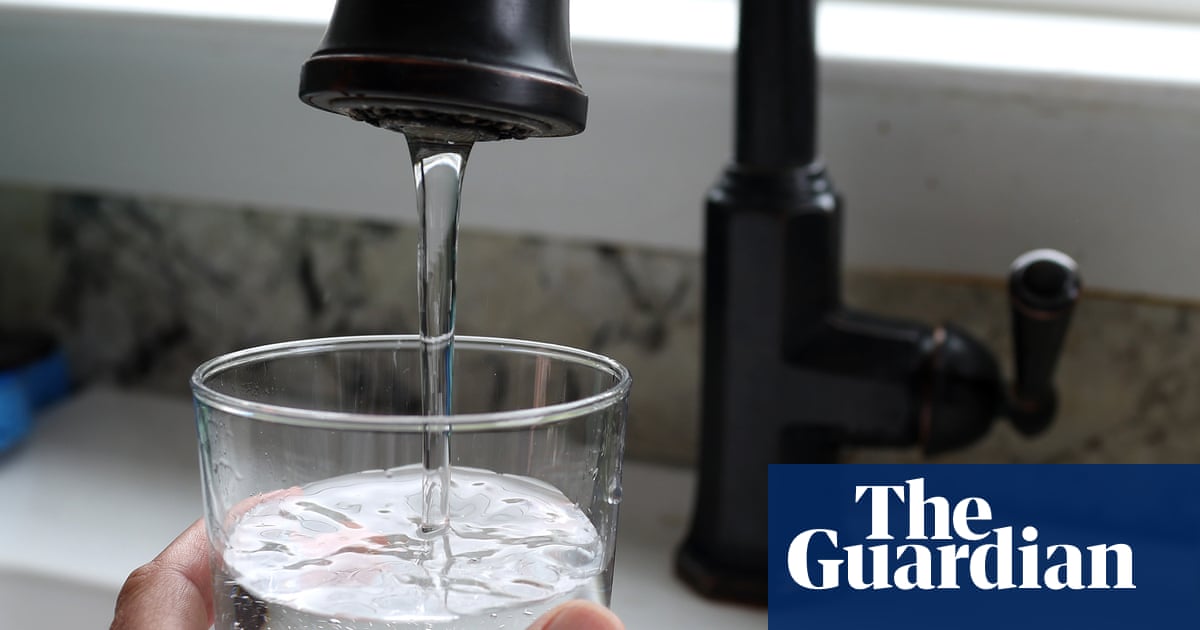
Tom Kennedy learned about the long-term contamination of his family’s drinking water about two months after he was told that his breast cancer had metastasized to his brain and was terminal.
The troubles tainting his tap: per- and polyfluoroalkyl substances (PFAS), a broad category of chemicals invented in the mid-1900s to add desirable properties such as stain-proofing and anti-sticking to shoes, cookware and other everyday objects.
Manufacturers in Fayetteville, North Carolina, had been discharging them into the Cape Fear River – a regional drinking water source – for decades.
“I was furious,” says Kennedy, who lives in nearby Wilmington. “I made the connection pretty quickly that PFAS likely contributed to my condition. Although it’s nothing that I can prove.”
The double whammy of bad news came more than three years ago. Kennedy, who has outlived his prognosis, is now an active advocate for stiffer regulation of PFAS.
“PFAS is everywhere,” he says. “It’s really hard to get any change.”
Indeed, various forms of PFAS are still used in a spectrum of industrial and consumer products – from nonstick frying pans and stain-resistant carpets to food wrappers and firefighting foam – and have become ubiquitous. The chemicals enter the environment anywhere they are made, spilled, discharged or used. Rain can flush them into surface sources of drinking water such as lakes, or PFAS may gradually migrate through the soil to reach the groundwater – another key source of public water systems and private wells.
For the same reasons the chemicals are prized by manufacturers – they resist heat, oil and water – PFAS also persist in the soil, the water and our bodies.
More than 200 million Americans may be drinking PFAS-contaminated water, suggests research by the nonprofit Environmental Working group (EWG), an advocacy group which is collaborating with Ensia on its Troubled Waters reporting project.
As studies continue to link exposures to a lengthening list of potential health consequences, scientists and advocates are calling for urgent action from both regulators and industry to curtail PFAS use and to take steps to ensure the chemicals already in the environment stay out of drinking water.
Thousands of chemicals
PFAS dates back to the 1930s and 1940s, when Dupont and Manhattan Project scientists each accidentally discovered the chemicals. The Minnesota Mining and Manufacturing Company, now 3M, soon began manufacturing PFAS as a key ingredient in Scotchgard and other non-stick, waterproof and stain-resistant products.
Thousands of different PFAS chemicals emerged over the following decades, including the two most-studied versions: PFOS and PFOA. Oral-B began using PFAS in dental floss. Gore-Tex used it to make waterproof fabrics. Hush Puppies used it to waterproof leather for shoes. And DuPont, along with its spin-off company Chemours, used the chemicals to make its popular Teflon coatings.
Science suggests links between PFAS exposure and a range of health consequences, including possible increased risks of cancer, thyroid disease, high cholesterol, liver damage, kidney disease, low birth-weight babies, immune suppression, ulcerative colitis and pregnancy-induced hypertension.
“PFAS really seem to interact with the full range of biological functions in our body,” says David Andrews, a senior scientist with EWG. “Even at the levels that the average person has in this country, these chemicals are likely having an impact.”
The US Centers for Disease Control and Prevention (CDC) has even issued a warning that exposure to high levels of PFAS might raise the risk of infection with Covid-19 and noted evidence from human and animal studies that PFAS could lower vaccine efficacy.
Once PFAS gets into the environment, the chemicals are likely to stick around a long time because they are not easily broken down by sunlight or other natural processes.
Legacy and ongoing PFAS contamination is present across the US, especially at or near sites associated with fire training, industry, landfills and wastewater treatment. Near Parkersburg, West Virginia, PFAS seeped into drinking water supplies from a Dupont plant. In Decatur, Alabama, a 3M manufacturing facility is suspected of discharging PFAS, polluting residents’ drinking water. And in Hyannis, Massachusetts, firefighting foam from a firefighter training academy is the likely source of well-water contamination, according to the state. Use of PFAS-containing materials such as firefighting foam at hundreds of military sites around the country, including one on Whidbey Island in Washington state, has also contaminated many drinking water supplies.
“It works great for fires. It’s just that it’s toxic,” says Donald (Matt) Reeves, an associate professor of hydrogeology at Western Michigan University in Kalamazoo who studies how PFAS moves around, and sticks around, in the environment. It can be a near-endless loop, he explains. Industry might discharge the chemicals into a waste stream that ends up at a wastewater treatment plant. If that facility is not outfitted with filters that can trap PFAS, the chemicals may go directly into a drinking water source. Or a wastewater treatment facility might produce PFAS-laced sludge that is applied to land or put into a landfill. Either way, PFAS could leach out and find its way back in a wastewater treatment plant, repeating the cycle. The chemicals can be released into the air as well, resulting in some cases in PFAS getting deposited on land where it can seep back into drinking water supplies.
His research in Michigan, he says, echoes a broader trend across the US: “The more you test, the more you find.”
In fact, a study by scientists from EWG, published in October 2020, used state testing data to estimate that more than 200 million Americans could have PFAS in their drinking water at concentrations of 1 part per trillion (ppt) or higher. That is the recommended safe limit, according to some scientists and health advocates, and is equivalent to one drop in 500,000 barrels of water.
“This really highlights the extent that these contaminants are in the drinking water across the country,” says EWG’s Andrews, who co-authored the paper. “And, in some ways, it’s not a huge surprise. It’s nearly impossible to escape contamination of drinking water.” He references research from the CDC that found the chemicals in the blood of 98% of Americans surveyed.
Inconsistent regulation
US chemical makers have voluntarily phased out their use and emission of PFOS and PFOA, and industry efforts are underway to reduce ongoing contamination and clean up past contamination – even if the companies do not always agree with scientists on the associated health risks.
“The weight of scientific evidence from decades of research does not show that PFOS or PFOA causes harm in people at current or historical levels,” states Sean Lynch, a spokesperson for 3M. Still, he says that his company has invested more than US$200m globally to clean up the chemicals: “As our scientific and technological capabilities advance, we will continue to invest in cutting-edge cleanup and control technology and work with communities to identify where this technology can make a difference.”
Thom Sueta, a company spokesperson for Chemours, notes similar efforts to address historic and current emissions and discharges.
Environmental officials fined the company after its Fayetteville plant in NC dumped large quantities of the PFAS compound GenX, contaminating the drinking water used by Kennedy and some 250,000 of his neighbors.
Sueta said in an email: “We continue to decrease PFAS loading to the Cape Fear River and began operation this fall of a capture and treatment system of a significant groundwater source at the site.”
***
Most of the ongoing PFOS and PFOA contamination appear to come from previous uses cycling back into the environment and into people, Andrews says.
A big part of the challenge is that PFAS is considered an emerging contaminant and is, therefore, not regulated by the US Environmental Protection Agency (EPA). In 2016, the EPA set a non-binding health advisory limit of 70 ppt for PFOA and PFOS in drinking water. The agency proposed developing federal regulations for the contaminants in February 2020 and is currently reviewing comments with plans to issue a final decision this winter.
Several US states have set drinking water limits for PFAS, including California, Minnesota and New York. Michigan’s regulations, which cover seven different PFAS chemicals, are some of the most stringent. Western Michigan University’s Reeves says that the 2014 lead contamination crisis in Flint elevated the state’s focus on safe drinking water.
Still, the inconsistency across the country has created confusion. “The regulation of PFAS remains varied. States are all having different ideas, and that’s not necessarily a good thing,” says David Sedlak, a professor of civil and environmental engineering at the University of California, Berkeley. “People are uncertain what to do.”
The Interstate Technology and Regulatory Council, or ITRC, a coalition of states that promotes the use of novel technologies and processes for environmental remediation, is working to pull together evidence-based recommendations for PFAS regulation in the absence of federal action.
University of Southern Denmark and Harvard professor Philip Grandjean suggests a safe level of PFAS in drinking water is probably about 1 ppt or below. The European Union’s latest risk assessment, which Grandjean says corresponds to a recommended limit of about 2 ppt for four common PFAS chemicals, is “probably close”, he says. “It’s not a precautionary limit, but it’s certainly a lot closer than EPA’s.”
GenX, introduced in 2009 by DuPont to replace PFOA, is among a newer generation of short-chain PFAS designed to have fewer carbon molecules than the original long-chain PFAS. These were initially believed to be less toxic and more quickly excreted from the body. But some evidence is proving otherwise: studies suggest that these relatives may pose many of the same risks as their predecessors.
“The family of PFAS chemicals being used in commerce is a lot broader than the small set of compounds that the EPA is considering regulating,” says Sedlak. “Up until now, the focus of discussion related to regulation has centered around PFOS and PFOA with some discussion of GenX. But the deeper we dig, the more we see lots and lots of PFAS out there.”
Andrews notes that the ongoing pattern of replacing one toxic chemical with another is a problem that the federal government urgently needs to fix. “This entire family of chemicals shares many of the same characteristics,” he says.
Environmental health advocates express hope that 2021 will bring greater progress on PFAS regulation. President-elect Joe Biden has pledged to set enforceable limits for PFAS in drinking water and to designate PFAS as a hazardous substance – which would accelerate the cleanup of contaminated sites under the EPA’s Superfund program.












